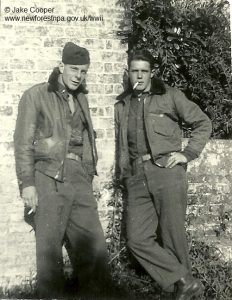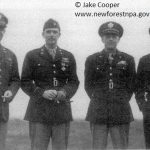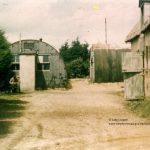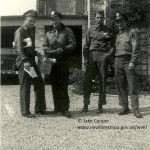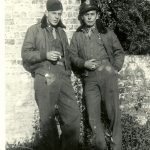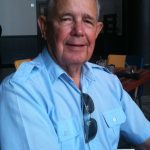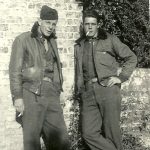Memories of an Ibsley Thunderbolt Pilot
An oral history interview with Colonel Jacob L. Cooper, DFC (retd). Interviewed in 2012 by the RAF Ibsley Airfield Heritage Trust.
Jake Cooper arrived at RAF Ibsley in April 1944 as a 2nd Lieutenant replacement pilot. There he joined the 493rd Squadron, 48th Fighter Group of the 9th USAAF that had been stationed at Ibsley from March. There were three squadrons based at the airfield which made up the 48th Fighter Group: the 492nd, 493rd and 494th. The squadrons were to form part of the offensive in the build-up to D Day, on D Day itself and for a short time afterwards.
Jake and his fellow pilots flew P47-D Republic Thunderbolts from RAF Ibsley. These were fighter-bombers and missions flown comprised bomber escorts for the 8th USAAF and, largely, sorties to dive-bomb and strafe enemy positions, communications and transport in France. On D Day they flew strafing missions to support the beachhead landings and subsequently the advance of front line troops. Jake flew his eighth combat mission on D Day + 1: the day following D Day.
Jake’s billet was a Nissen Hut within the grounds of Ibsley Grange where his squadron were accommodated, while the 492nd were stationed at Cuckoo Hill, now Heywood Sumner House in Gorley. Jake left Ibsley in late June, transported in a Dakota to an Advanced Landing Ground, A-4, located behind Omaha Beach at Deux-Jumeaux in Normandy.
You can find out more about Ibsley Airfield in this overview article, which has links to other articles relating to Ibsley Airfield
Interview Quick Clips:
All material is ©2012 RAF Ibsley Airfield Heritage Trust.
Transcription of Quick Clips
1 – From New York to Ibsley
We all took a train from Louisiana to New York City and waited for a boat and we finally left New York on March 28th 1944. Our British ship which was named the Esperance Bay, it was converted from a transporting-type ship to a troop carrier. I mentioned our bunks before I think; they were only 3 bunks high, the room was very narrow but we spent a lot of our time up on deck. So we arrived in Portsmouth, England, waited a few days and waited a few days for transportation – land transportation – to take us to our next base, and finally got off the Esperance Bay on April 9th, 1944: Palm Sunday as I recall.
We went as a group to a place called Atcham where new pilots received what they called their Theatre Training – getting used to the tactics and procedures to be used overseas. I flew my first flight from Atcham on April 29th 1944 and accumulated only 21 hours or so of flight time there. We then, after completion of that short training period, we were assigned to various combat units in the European Theatre. Most of us at that time went to the Ninth Air Force as opposed to the Eighth which had responsibility for long-range bombing; the Ninth being a more tactical airforce supporting the frontline troops. Twelve of us who went overseas together, out of the big group, were assigned to the 48th Fighter Group which at that time was located in Ibsley in the southern part of England not too far from Bournemouth.
2 – Accommodation at Ibsley
Well, when the four of us arrived at Ibsley we were hoping to meet the rest of the pilots and hoping to stay with them but the large English, manor-type home they were assigned to had no more room for us. So there was a Nissen Hut nearby: a metal-roofed structure with a cement floor, probably 40 feet long or so, where the new pilots were assigned for quarters. It was a bit rustic but we had canvas cots and set up our living quarters and it really wasn’t that bad. But I found out later that it was very close to the house where the other pilots were staying and there was a great deal of socialising between the buildings between the buildings and in the grounds
3 – Types of mission
I think my first mission was May 23rd 1944 and I flew a total of 14 missions from Ibsley before we moved over to Normandy, and most of those missions were very short durations whereas the escort missions were 3-4 hours long. Our missions across the Channel and into France were maybe only one to what, an hour-and-a-half long. We were primarily dive-bombing and strafing the bridges, railroad yards and German positions, personnel and equipment, trucks and tanks; trying to destroy as many as we could.
4 – D Day+1 and a mission on 12.6.44
Well, it was unbelievable. First, I don’t know how many airfields there were in England but there were hundreds of airfields and the 9th Air Force, that we were a part of, had many many of these airfields and it was a stream of aircraft flying across the Channel and into France and hopefully the same number returning; of course that was always not the case. What I remember mainly was the number of ships in the Channel heading towards the beachhead and at the beachhead, and as far you could see there were ships taking part in the invasion. And I do recall, and I’ll never forget the date on June the 12th of ’44; this was slightly before we left Ibsley, we were patrolling the beachhead with the mission of preventing German fighters harassing our forces down below. We were probably 12-15,000ft and we did encounter some German fighters who were going to probably strafe and bomb the ships in the Channel. Well, we had quite a dogfight. Of course, I was flying Tony Porter’s wing and, as a wing-man, your job was to protect the tail of your Flight Leader while he was engaging in a dogfight. I was not involved very much in attacking anyone – any German fighter – I was involved in protecting Tony Porter’s tail so that he was not shot at from behind. But I think our squadron did shoot down three or four Germans that particular day.
5 – Avoiding flak
…there was…mainly at the higher altitude it was the German 88mm artillery that reached up there. And, usually you could see the puff…black puffs of smoke of the shells exploding nearby and you always…you never flew in a straight line; always in one direction and then maybe turning 10, 15 degrees in another direction, always towards the target, or towards the base, and you never flew at the same altitude: you always flew a bit higher or a bit lower because the German shells were timed to go off at a specific altitude. That was just one way to evade the German 88s. But closer to ground the German 40mm anti-aircraft artillery were very effective and usually in our low-level missions – dive-bombing and strafing – it would be a rare occasion if you didn’t come back with a few holes in the plane.
Interviewed by: RAF Ibsley Airfield Heritage Trust
Transcription by: RAF Ibsley Airfield Heritage Trust
Audio Editor: Gareth Owen


